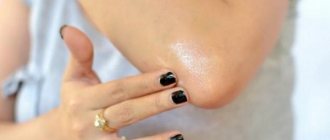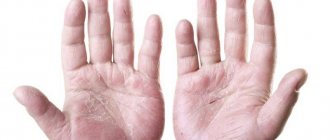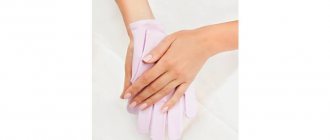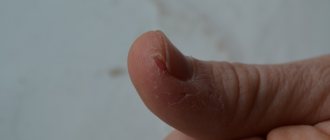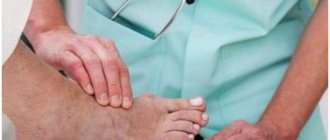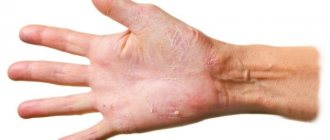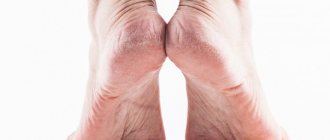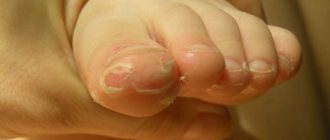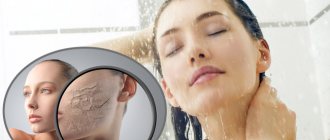Reasons for appearance
The skin becomes dry and cracked due to the fact that it has weak protection in the form of a lipid film on the surface. It is this that prevents the negative impact of external factors on the epidermis and maintains its attractive appearance.
The protective film of the skin consists of special proteins and oils. Each person has a different intensity of release of these substances. This is influenced by the characteristics of the body and the state of health. When the integrity of the film is broken, the skin dries and bursts.
The presence of microtraumas on the surface of the epidermis increases the risk of developing bacterial infections, which poses a potential danger to human health.
Preventing cracks in the skin of the hands or feet with apple cider vinegar
If you don’t want to see the skin of your feet cracking between the toes and on the heels due to fungal diseases, get used to taking preventative baths with apple cider vinegar. To prepare one bath you need to take a liter of warm water and three tablespoons of vinegar. By periodically doing such vinegar procedures for 15 minutes, you will not have to deal with peeling and cracks in the future due to the development of a fungal infection.
Important: after the vinegar bath, be sure to walk over your feet with a pumice stone and do not forget to rinse them with warm water.
Useful links:
What diseases provoke the problem?
The appearance of cracks on the feet or other parts of the body may indicate the presence of diseases that require mandatory treatment . To identify them, you need to contact a therapist. He will examine problem areas, refer you for tests and, if necessary, recommend consultation with a highly specialized specialist - a dermatologist, endocrinologist, or allergist.
Infectious and non-infectious diseases
If the skin on the legs breaks and other unpleasant symptoms appear, there is a possibility that the person has one of the following diseases:
- Eczema - accompanied by severe itching, the appearance of blisters and ulcers.
- Fungal infection. The development of cracks in the toes, itching, burning and signs of inflammation may indicate the presence of mycosis.
- Ichthyosis. This disease is transmitted genetically. It is characterized by a disruption of the keratinization process of the skin, which leads to the appearance of hard scales.
- Psoriasis. If the skin is cracked, has acquired a reddish tint and is covered with dry scales, the development of this disease can be suspected.
- Atopic dermatitis has a genetic predisposition and usually occurs chronically.
Diseases of internal organs
If your hands are cracking and itching, it is necessary to undergo a comprehensive examination of the body, since the problem can arise against the background of the following pathologies:
- hormonal imbalance and various endocrine disorders,
- allergic reaction to food, pollen or other groups of allergens,
- lack of vitamins, micro-, macroelements,
- disruption of the gastrointestinal tract,
- presence of Sjögren's syndrome, Reiter's syndrome,
- natural changes in the body associated with age.
How to eat right to keep your skin hydrated
Hydrate your body – Lack of water and nutrients in your diet can lead to cracked heels. Make sure your body is well hydrated. This includes drinking clean filtered water and eating foods high in water content such as cucumbers, watermelon, cantaloupe, lettuce and greens.
Collagen - The main function of collagen is to support cartilage, tendons and skin. Adding collagen to your diet is an easy way to improve skin hydration and elasticity. It's easy to include collagen powders in your diet, as there are many powder forms available online and in health food stores. Consider adding collagen powder to smoothies, jellies, gummies, and sauces.
Essential fatty acids - Help protect the outer layer of skin. Foods that contain them include fatty fish such as salmon, sardines and freshwater trout. Vegetable oils such as safflower, sunflower, olive oil and sesame. Nuts and seeds include walnuts and flaxseeds, as well as vegetables such as avocados, cauliflower, Brussels sprouts, broccoli and cabbage.
Lipoic acid. Foods high in lipoic acid include poultry, green leafy vegetables, liver and tomatoes.
Cellulose. Most of us simply don't consume enough fiber. Fiber is important to help regulate your bowels and help remove toxins from the body, such as smoke and environmental pollutants, which can contribute to dry skin.
Make a lotion for cracked heels
Ingredients:
- 1/4 cup avocado oil;
- 1/4 cup magnesium oil;
- 3/4 cup cocoa butter;
- 30 drops of lavender oil;
- Large glass jar.
How to do:
- Place the jar of cocoa butter in a saucepan of water over low heat.
- Once melted, pour into a bowl and let cool in the refrigerator for 30 minutes.
- Using a standard mixer, beat the mixture.
- After whisking, add magnesium oil, avocado oil and essential oils, and then mix.
- Pour into a glass jar or plastic container and store in the refrigerator for 90 days.
Foot scrub with sea salt
Use this simple recipe to create a DIY sea salt foot scrub that will help exfoliate your feet and heal cracked heels.
Ingredients:
- 1 cup coarse sea salt;
- 5 tablespoons coconut oil;
- Three drops of mint or lavender essential oil.
Instructions:
- Mix all ingredients in a labeled jar and store in a cool place.
- Soak your feet in warm water for 10-15 minutes.
- Use an egg or pumice stone to remove thick calluses.
- Rub the DIY foot exfoliator into your heels or other calloused areas of your feet using light, circular motions.
- Rinse and dry your feet thoroughly, then apply an herbal ointment or favorite lotion.
Herbal oil or ointment: recipe
The masks are incredibly versatile and easy to make. Some people claim that this is the best foot cream for cracked heels. You can vary the herbs depending on your personal preference or what you need the ointment for.
Ingredients:
- 1 cup butter;
- From 30 to 60 grams of dried herbs.
Instructions:
- Add 1 cup of oil to the pan. (I use olive oil).
- Add about herbs. (I like the combination of calendula, plantain and St. John's wort). Place on the stove.
- Keep the burner at the lowest possible temperature for 3-5 hours until the oil takes on the color and smell of herbs.
- Pour oil into the filter. Squeeze the herbs to remove all the oil.
For now, you can save this as an infused herbal body butter or follow the additional steps to create a balm. If you store oil, be sure to place it in a labeled jar. Infused body butter will last approximately one year if stored properly in a cool, dark place. You can also add vitamin E oil as a preservative to extend shelf life.
From herbal body butter to herbal ointment
Some people prefer creams to oils when it comes to texture. If you like the former, this is your chance to make the best foot cream for cracked heels. It takes a few minutes to transform the body butter into a balm. You can customize your salve for a softer or firmer consistency by simply adjusting the beeswax. The basic formula for the balm is 30 grams of beeswax for every cup of oil.
Ingredients:
- 30 grams of beeswax for every cup of oil.
Instructions:
- Place the infused oil in a saucepan and heat. Add the wax to the oil and let the wax melt.
- Remove the pan from the heat and dip a spoon into the butter mixture.
- Place the spoon in the refrigerator or freezer to test the consistency, long enough to harden.
- Take out the spoon and check your ointment. If it is too soft, add more beeswax. If too hard, add more oil.
- Repeat the steps above until you reach the desired sequence. Once the mixture reaches the desired consistency, pour into jars or containers and let them harden.
- Be sure to label your creations and store them in a cool place.
In most cases, subsequent prevention and treatment options will produce positive results within a week. If cracked heels and dryness are not healing during this time, consider adding nutritional support. If these methods do not produce positive results within a few weeks, then you can consult a podiatrist.
( Also read: Peeling and cracks on the lips. Lipstick subtleties!).
Temperature and mechanical influence
The appearance of dryness on different parts of the body is sometimes associated with the following provoking factors:
- The habit of sitting or standing, leaning on your elbows. As a result of heavy loads, the skin in these areas becomes rough, dries and becomes cracked.
- Drying the body too intensively with a towel, which leads to irritation of the skin at the site of exposure.
- Sudden changes in temperature.
- Incorrect use of scrubs. This product can be applied to the body no more than twice a week. If you use the scrub uncontrollably, the protective film on the skin will not have time to recover, which will lead to dryness and a feeling of tightness .
- Negative effects of wind, frost or, conversely, high temperature.
Diagnostics
When should I make an appointment and with which doctor?
If the skin on your hands dries and cracks for a long time and the process does not subside even after using moisturizing creams, then a visit to a dermatologist is recommended. First, you need to rule out a fungal infection. To do this, a scraping will be taken from the lesions and sent for microscopic examination.
Secondly, you need to understand that in the presence of dermatitis or eczema, only an experienced dermatologist will be able to select the right set of drugs that will help not only with exacerbations, but also “hold back” the inflammatory process for as long as possible.
In any case, a visit to a dermatologist will definitely not be superfluous, since even well-known psoriasis at the initial stage can cause dry skin and the appearance of small cracks on the hands.
Parasites
The presence of irritations on the surface of the feet, between the toes or on other parts of the body always indicates the presence of health problems.
Sometimes dryness and cracks appear in the presence of helminths. Parasites increase the permeability of the intestinal mucosa, as a result of which it intensively absorbs various harmful substances that were previously successfully eliminated from the body.
Parasites are perceived by the human immune system as foreign objects. Therefore, she directs her forces to destroy them. This leads to the fact that the immune system cannot cope with other negative effects on the body. A person becomes more susceptible to external irritants, which most often provoke dryness.
Preventive actions
To prevent cracks and dry skin, you should follow simple rules:
- Wash your hands and body only with special care products that do not dry the skin and nourish it.
- Regularly moisturize your body using creams or lotions specifically formulated for this purpose.
- Use rubber gloves when working with household chemicals.
- Drink more water, slightly limit your consumption of coffee and tea.
- In winter, wear gloves outside to protect your skin from frost and wind.
- Constantly monitor the air humidity in the room and use humidifiers if necessary.
- Eat right, take additional vitamins if necessary.
If you follow simple rules, the problem of dry hands or other parts of the body will disappear on its own. But in the presence of more serious pathologies, special treatment is no longer possible.
Treatment
If the skin is severely cracked, you need to find out what led to the problem, and then begin treatment. Otherwise, the effect of the therapy will be short-lived.
Medicines
The best way to quickly get rid of dryness is to use one of the following pharmaceutical products:
- Based on dexpanthenol and chlorhexidine. Substances accelerate skin healing and help eliminate inflammation. The most popular drugs from this group are Bepanten and Panthenol.
- Preparations with antiseptic action. Helps neutralize pathogenic microflora, which prevents the development of inflammation. The most popular products from this group are Miramistin, hydrogen peroxide, Fukortsin.
- Antibacterial ointments. Recommended for use in cases of severe inflammation. The most popular medications are Levomekol, Solcoseryl.
- Other agents with regenerating, anti-inflammatory effects. These are Radevit, Actovegin, Methyluracil. Vulnuzan.
- Medicines with antifungal effect. If cracks and irritation on the skin appear due to a fungus, drugs such as Pimafucin, Nystatin, Clotrimazole should be used. They can be applied externally, or in more serious cases, taken orally. The course of treatment should continue until all external manifestations of the disease completely disappear.
- Drugs with antiallergic effect. If skin irritation occurs due to allergies, antihistamines are prescribed. These include Loratadine, Diazolin, Eden.
Folk recipes
If you have skin problems, you can use home remedies:
- Sea buckthorn oil is mixed with natural honey in a ratio of 1:3. The resulting liquid is applied to sore hands in the evening, after which cotton gloves are put on and left until the morning. The medicinal composition can be applied to other problem areas of the body.
- A teaspoon of oatmeal is mixed with one yolk and a small amount of liquid honey. The product is applied to problem areas and left for some time.
- Raw potato puree is mixed with a small amount of milk. The resulting mass is applied to chapped skin and washed off after a few hours.
Vitamins
In many cases, taking additional vitamins will help cope with the problem of dry skin. It is best when they are prescribed by a doctor who will determine what substances and in what quantities a particular person lacks.
Multivitamin complexes to improve skin condition should contain vitamin A, C, E, group B, K, PP, and retinol.
Cosmetic preparations
There are many alternative cosmetics that help moisturize the skin and prevent the development of inflammation:
- Hydroactive. The cream is intended for hands. It not only improves the condition of the skin, but also has a positive effect on the nails.
- Velours. Moisturizes well, promotes healing of minor injuries, protects from negative external influences.
- Doctor Sante. A quality product designed to protect the skin of your hands from irritation. There is no sticky feeling left after use. It absorbs well and moisturizes.
- Homemade recipes. The cream contains peach oil and royal jelly, which promote intensive skin hydration and effectively combat dryness.
Use of medications
As mentioned above, you should not self-medicate if cracks appear. Any pharmaceutical creams and ointments must be prescribed by your doctor. You can use the “Rescuer” balm on your own (no longer than one or two days). It relieves pain well and moisturizes the epidermis.
The most commonly prescribed treatment is:
- Aevit. Take one capsule per day. Treatment continues for at least three weeks. This medicine helps to compensate for the lack of vitamins E and A, which are responsible for the integrity and health of the skin.
- Eplan. This ointment accelerates skin regeneration. Prescribed twice a day. After application, the drug covers the wounds with a microscopic film that prevents bacteria and other pathogens from penetrating into the cracks.
- Pantoderm. This remedy can be used at your own discretion - there is no strict dosage. The ointment improves metabolic processes, thereby affecting the speed of skin restoration.
- Radevit. This fortified ointment nourishes the epidermis, softens it and relieves inflammation. The drug is used twice a day.
- Bepanten or Depanthenol. Both drugs contain chlorhexidine, an active component that has a disinfecting effect. The second important element is vitamin B, which accelerates regeneration. You can apply the ointment to your hands up to four times a day.
Any self-medication is unacceptable, as it can worsen the condition of the skin! Only an experienced dermatologist is able to determine which drug is suitable for the patient in a particular case.
Classification
Using the classification accepted in medicine, we can conditionally divide the most common types of cracks into certain varieties depending on criteria such as the location of the crack, the type of rupture, and its depth.
With different depths, cracks in the skin are divided into two main groups:
- Epidermal , which are located in the upper layer of the skin and are more easily treated, without leaving visible marks on the skin.
- Dermal cracks , which already affect the deeper layers of the skin, requiring more serious and comprehensive treatment. After healing, they leave noticeable scars and marks on the surface of the skin.
These two groups of cracks in the skin determine the type of therapeutic effect, since epidermal and dermal cracks differ in the depth of tissue damage, which significantly affects the possibility and speed of their healing. To eliminate mechanical cracking of the skin of the dermis, it is necessary to use more potent drugs that can quickly restore both the integrity of the skin and the normal functioning of the dermis.
Depending on the location of the crack, the method of treatment is determined, since cracks in different places of the body are amenable to treatment to varying degrees. The most common locations for skin cracks are:
- on the skin of the hands and palms - in this area the skin experiences significant stress due to the fact that the fingers, being in constant movement, cause frequent tension in the skin and, as a result, the risk of excessive tension and rupture increases;
- on the fingers and between them - the fingers and the area between the fingers are exposed to frequent and varied external influences, which are often quite aggressive, and a gradual thinning of the skin occurs, increasing the risk of its rupture and cracking;
- on the skin of the legs : heels, feet, between the toes - the legs, also experiencing significant stress during the day, are subject to mechanical stress while walking and running, and with insufficient care, excessive dryness of the skin in this area and further cracking may occur;
- behind the ears and on the neck - behind the ears and in the folds of the skin on the neck, sweat and dirt can accumulate, which, with insufficient personal hygiene, can cause irritation of the skin and increase its susceptibility to external influences, and then to tears and cracks;
- on the coccyx - this area experiences stress while sitting, therefore the coccyx area is also considered one of the most susceptible to mechanical stress;
- on the skin of the penis - lack of personal hygiene, unfavorable external conditions can cause cracks to form on the delicate skin of the penis;
- between the buttocks - with excessive sweating, there is a high probability of sweat getting into the area between the buttocks, which first provokes irritation of this area, and then the appearance of cracks.
The areas listed are not the only ones where skin cracking can occur. However, it is these areas that are more susceptible to cracking with the formation of deep and quite painful cracks that require attention and a number of treatment procedures.
The video below will tell you how to deal with dry skin on your hands:
